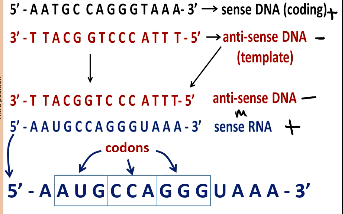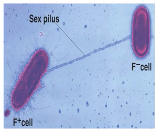Microbiology Chapter 8: Microbial Genetics
There are two aspects of microbial genetics → Genotypes (genes inherited) and the phenotype (the expression of gene inherited)
Microbial phenotype (observable traits) is determined by the function of proteins encoded by the genotype (genetic makeup). The flow of information from DNA to RNA to protein underpins this connection.
Genotypes contain the genetic material that make up genes which code for proteins. These proteins make up the phenotypes that are expressed.
Flow of information: DNA → RNA → protein
If you change the nucleic acid sequence, you can affect what kind of protein that’s being produced which then affects what phenotype comes about
Genotype is preserved by being replicated and copied to be passed down to the daughter cells
Central dogma - the theory that explains how genetic information flows from DNA to RNA to protein
Prokaryote genome:
single circular chromosome + any plasmids
Inheritance: vertical & horizontal transmission of genes
vertical: think parent to child
horizontal: combination of genes from others in the population; acquiring different cells from neighboring cells and its environment
DNA structure → information storage
Nucleotide base sequence → genes
Complimentary structure facilitates duplication of DNA; semiconservative replication:
the two strands of DNA is basically unzipped from each other in order to have two separate halves of a DNA. It’s then filled in by it’s complimentary match.
half of the old ladder or DNA is kept while the other part is replaced, giving you two new ladders.
Prokaryote genetic → Genome (DNA) → Chromosome, plasmid → genes → proteins
Gene Expression:
retrieval of info
genetic code
employs different RNAs
Transcription (creating multiple copies of DNA)
transcribes a gene
RNA polymerase
mRNA transcripts
Translation
ribosomes (rRNA)
transfer RNA - specific to carry the amino acid and can read the transcripts
Ribosome binding site is needed as it’s what ribosomes look for to initiate translation
DNA the instructions (genes) to build the proteins necessary for our body. → a specific gene is needed, the DNA where that gene is located unzips. This unzipping happens at just one part of the DNA—where the gene is. (When semiconservative replication happens) → An enzyme called RNA polymerase comes in and makes a copy of one side of the unzipped DNA. But instead of copying it as DNA, it makes a similar kind of molecule called mRNA (messenger RNA). → The mRNA carries the instructions to ribosomes. The ribosome reads the mRNA message and assembles the proteins.
Polysome formation - multiple ribosome on a transcript because transcription and translation happens together
Sense (coding) - start with the 5.
Antisense (non-coding, template) - start with a 3,
copied and used to make the sense RNA
mRNA sense strand is identical to the DNA sense strand except for the T/U substitutes
There’s a starting codon and a stop codon that act as punctuation
Genetic code:
there’s redundancy: 64 codons to code 20 amino acids
represents mRNA
start/stop codons

Mutations - permanent alterations of the DNA base sequence
caused by chemical, radiation → mutagens
Mutation in a gene → can be silent, lethal, or beneficial
Auxotroph: nutrition mutants
Spontaneous mutation: random mistakes during replication
One per 106 replicated genes
Base substitutions (point) mutations
Missense mutations - when a single nucleotide is changed in the DNA sequence resulting in an amino acid substitution
An example would be the codon CCG translating into GCC which creates Phe. However, the C is changed into a T which creates TCG translating into ACG which creates Ser instead
How detrimental a missense mutation depends on how dramatic the change of amino acids, the nature of the amino acid substitution, and where the mutation occurred.
Nonsense mutation - when a single nucleotide is changed in the DNA sequence and changes a normal codon into a stop codon
Since stop codon forms prematurely, it ends the translation process early making it lethal for the most part.
Frameshift - insertion or deletion of a single base nucleotide
causes a change in amino acid sequence following the insertion or deletion site
typically lethal as well
Gene Transfer
Prokaryote genomes are a composite of genes gained by:
Vertical transmission & horizontal transmission
Variation of genes can occur from mutations and horizontal transmission
The mechanisms of horizontal gene transfer:
Donor cell provides DNA segment → recipient cell takes DNA and recombines it with its own chromosomal DNA through transformation, conjugation, transduction, or transposition → forms new gene combination
Transformation - uptake of DNA from the environment (naked DNA)
Conjugation - transfer of DNA via cell-to-cell contact
Transduction - DNA transfer via a virus or viral intermediate
Transposition - transfer of transposons (jumping genes or short DNA segments)
EX: plasmids
Not entire chromosomes are being transferred. Only partial segments of DNA is being transferred using these mechanisms
DNA fragments don’t have a long life in the bacterium so it has to recombine with the chromosome in order to coexist within in it.
Recombination
RecA protein - mediates recombination between donor/recipient
It has to have some level of similarity because it recombines at homologous (similar) regions → crosses over at homologous regions
Gains new functions
repair defective genes or damaged DNA
contributes to genetic diversity of population
Frederick Griffith’s “Transforming Principle”
Discovered transformation - the transfer of “naked” DNA from cell to cell in solution
Heat-killed virulent forms of S. pneumoniae lysed; cells released DNA, taken up by live non-virulent forms
descendent of these cells expressed the virulent phenotype; they were “transformed” to virulent types
His experiment:
Injecting live S strain into mice: The mice died, and live S bacteria were recovered from their bodies.
Injecting live R strain into mice: The mice survived, and no bacteria were recovered.
Injecting heat-killed S strain into mice: The mice survived because the heat-killed bacteria could not cause disease.
Injecting live R strain with heat-killed S strain: The mice died, and to Griffith's surprise, live S strain bacteria were recovered from the dead mice.
Competence - cell envelope changes occur enabling uptake of DNA
Cells that are competent are ready to take up DNA
Some bacterial types are naturally transformable (become naturally competent)
Others undergo artificial transformation; made to be competent via:
chemical treatment, electrical shock
Recombination of external DNA fragment with chromosomes required to become part of the cell’s genome
Plasmids
Plasmids - small, extrachromosomal circular segments of DNA, generally around 2-25 kbp in size
Relates to transposition
replicates autonomously
possesses own origin of replication (ori)
conjugative plasmids - possesses genes that allow it to be mobilized → from one cell to another
are transferrable; need F (fertility) factor to be transferable
possess ori for conjugative transfer
catabolic genes on plasmids
virulence genes on plasmids
R factors (resistance)
carry antibiotic resistance
Artificial plasmids exists
Conjugation - involves cell to cell contact & transfer of DNA via a sex pilus
occurs in many bacterial, archaeal species
The fertility factor is what enables this
Fertility (F) factor: Donor F+ & recipient is F- cells
F factor is a conjugative plasmids

When the F- cell receives a copy of the F+ plasmid, it turns F+.
The recipient receiving an F factor may integrate it into its chromosome → resulting cell termed Hfr (high frequency of recombination) cell:
The Hfr cell allows the transfer of the entire chromosome

Conjugation of an Hfr cell with a F- cell results in the F- cell to remain a F-
Often times the integration of the entire chromosome takes a long time (usually 90 min) and usually the conjugation bridge is broken before the entire chromosome could be integrated.
Since the F factor is located deep in the chromosome, it is usually not integrated by the time the conjugation bridge is broken.
Since the cell was not able to integrate the F Factor, it remains an F- cell
It is still able to acquire the other genes
Transduction
Transduction - Bacterial viruses (phages) serve as the vehicle to transfer DNA between donor & recipient cells
Generalized transduction - any host gene can be transferred
phage attachment is put into host cell → DNA of cell combines with the virus/phages → phages exits and goes into new host → Donor and recipient DNA recombine
Specialized transduction - only specific host genes are transferred ( Shiga toxin, diphtheria toxin, cholera toxin)
Transposons - mobile genetic elements (700-40 kbp long); can move within chromosome but is part of the chromosome (unless it’s plasmids)
Frequency 10-5 to 10-7/generation
Possesses transposase gene that recognizes specific inverted repeat sequence called insertion sequences
Two different ways transpose move:
Cut and Paste
The Transposase gene recognizes insertion sequences in the DNA and cuts it out. The cut out part is then transferred.
Copy and Paste
Instead of being cut out, the transposons instead copy itself and then transferred
The transposase gene is not used in this method.
Instead the copy is an RNA copy of the transposon and converted back into DNA with reverse transcriptase
Simple transposons only transfer the transposase gene, the gene needed for their movement
Complex transposons - transfer the transposase gene along with other genes like antibiotic resistance
Transposons can move from cell to cell via plasmids or viral DNA and “jumps” off to the receiving cell chromosome